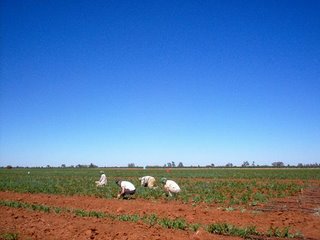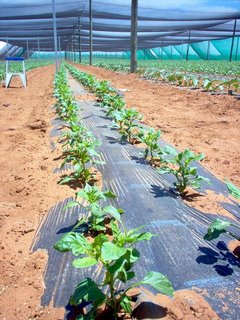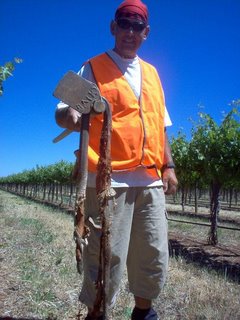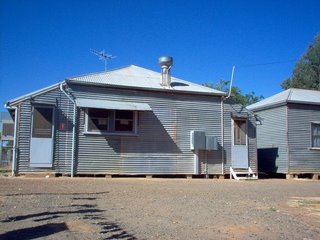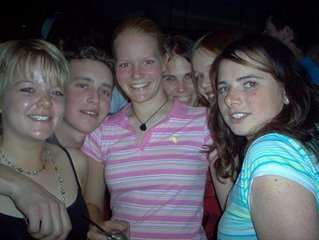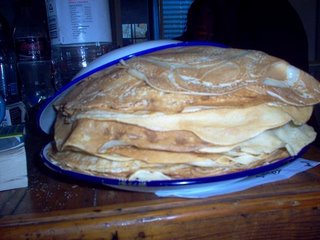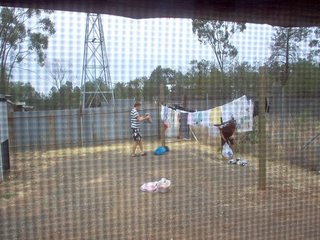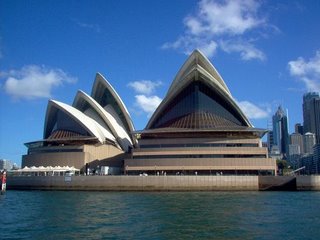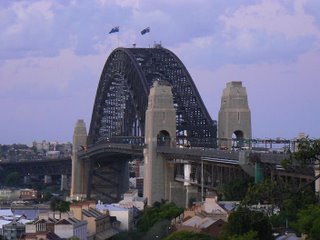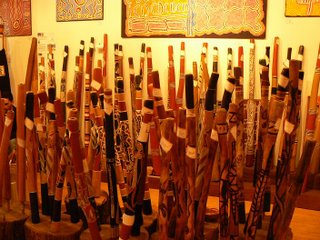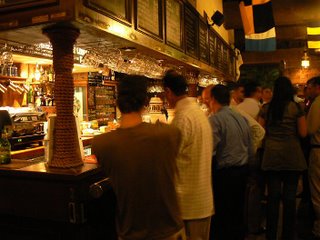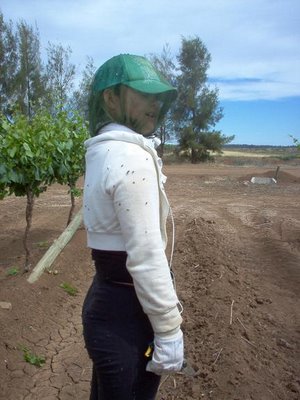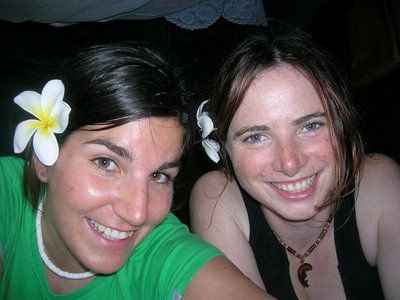Only half of the population of Fiji islands is Fijians. The rest are manly Indian which came to Fiji to work on sugar farms and some Chinees.
On the market we found special fork designed to soak out brains from someone’s body. Mhm. Hundreds of year ago there were cannibals on Fiji island. Buuuuuu freaky.
Fijian traditional drink is kava. Sounds familiar? Well it for sure doesn’t taste familiar, it taste like soil mixed together with water. Drinking it makes your mouth a bit paralysed, similar to chewing coca leaves in Bolivia (jut that coca leaves have stronger effect or maybe I should drink more of this un-tasty kava).
“Kava ceremony” normal takes place every night. Locals gather together, and men are the one preparing it. Women can also drink it. They put crushed kava (kava is kind of a root) into a cloth or sock and pour water on it. They mix it with hands in a special bowl with four legs. Before you drink it, you say “bula” which in this case means cheers but the expression is used also for saying hello, thank you, yes please ... It is most commonly used Fijian word. After saying “bula” you clap your hands 3 times, drink it and repeat the clapping with hands after you finish drinking it. People around you clap their hands together with you.
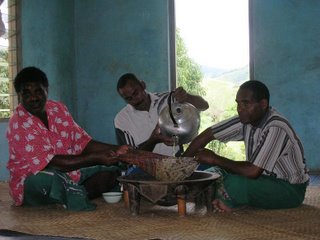
Pic 1: Kava ceremony
When you visit local village you must wear “sulu” to show respect (long cloth; look what I’m wearing on picture 3 Australia – Fiji – Australia (part one)). Except children, everyone wears it. It is not uncommon also for men to wear a skirt. Actually when a man wants to look nice and tidy he wears a skirt.

Pic 2: Tidy clothes
After getting to know a bit of real Fiji we said we finally needed the beach we were dreaming about since we left snow. In my mind was fabulous beach, lying on sand, getting sun tent, doing nothing. We were close, but not there yet.
We went to Mango bay resort. It’s very nice resort which except from the beach looks like great pictures from the magazine. Palm trees, small cottages (dorms or just made for 2 person just next to the beach), restaurant next to the pool, mini chairs in the pool so that you can have your cocktail in the pool, free sport activities… all for quite reasonable price (dorms (15 €), but much higher prices for small cottages for two).

Pic 3: Mango by resort
Hm … we stayed there for 2 nights. Weather wasn’t very nice, beach wasn’t as perfect as in magazine and I felt a bit like so called “prisoner tourist”. I mean it was nice to stay there for 2 days, but would be very bored to stay there for 3 weeks. It was like in hotel, breakfast at 9am, long way to the city if you needed to buy something … and after 2 days I still didn’t live to see my dreams; nice “sunny “beach, lying on sand, getting sun tent.
Since we got to Fiji I wanted to see that beach from film Blue Lagoon. It was supposed to be filmed on Vatulele, an Island close to Mango Bay. Prices: renting a cottage for 1 night in a Vatulele resort costs around 740€, flight there and back (from main Fiji Island to Vatulele Island) costs around 400€. MMM Now what? What if we would go by local boat and stay a night with locals, since we’re used to it? There must be a local boat going there. First offer we got was 200€, which still sounded a bit too much locals could afford. When we made it clear we want to go “with” locals (not having our own local boat) we finally got a boat for 12€. Happy as we were to finally make it, it turned out to be “the” most and scary experience of my life. I think I can’t call sky diving or bungee jumping or hitch hiking by myself in Peru “adrenalin” any more. You would probably put me across your knees and punch me like a child if you would know how this looked like. The boat was around 3m long and only 1m was covered with roof. Wind speed was around 30 nuts and there were supposed to be plenty of sharks in the water. After 5 minutes we grabbed each others hands, catching our breath and screaming every few minutes as the wave hit the boat lift it out of the water and smashed it back down. Local women kept on saying “vinaka vinaka” meaning “thank you”. Thank you god you didn’t sink us. Dreadful. The captain just smiled at our scary faces and kept on going. Waves kept on falling into the boat and on the captain. We were all soaked. Ana started asking locals on the boat: “Do you have children?” “Are you married?” Meaning you do need to get there, right? We spend one and a half hours on the boat (they first said one hour and the additional half an hour was not very welcomed, but what could we do, the weather just wasn’t good). As we were finally getting closer to Vatulele, the wind calmed down and last 10 minutes on the boat were calm.
Well as you can see, we made it and the captain later on told us, he can make it even if wind speed is 70 nuts or even more.
Was it worthy? Check out the photos, but I would definitely not go on the boat like this again (but I had to, to get back to main Fiji Ireland).
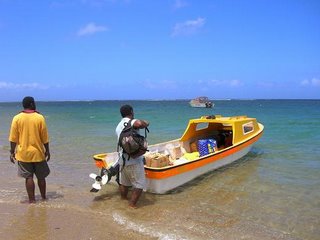
Pic 4: Our boat

Pic 5: Beautiful
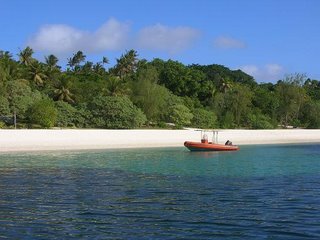
Pic 6: Beautiful
It was the sunniest day we had on Fiji islands. We also did some snorkelling for around half an hour. Beach was breath taking. We’ve actually seen the glamour rich people experience (Rich people don’t go to main Fiji Island, but to small islands around it).
Vatulele is supposed to be he only place on earth with red prawns. You know … prawns… normally turning red when you put them in boiling water… Well on Vatulele they are red without having to cook them (which you anyway shouldn’t else your boat will sink).

Pic 7: Red prawns

Pic 8: Dinner
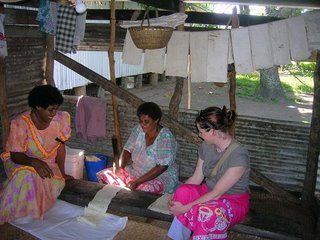
Pic 9: Paper making
We turned back to the main Fiji island with a bit less of wind (we as well had baby on board this time), but it was still freaky with the waves suddenly coming from the side this time. Our 10 days adventure was getting close to an end.
We turned back to Australia. J As coming home. In a way very nice, but on the other hand: “Where are all nice people with smile on their faces all the time?” We stayed a week in a youth hostel in Sydney, sightseeing lovely Sydney again.



